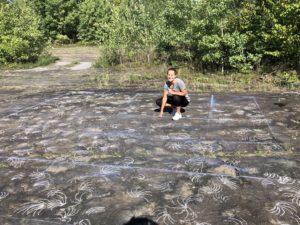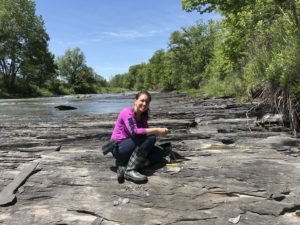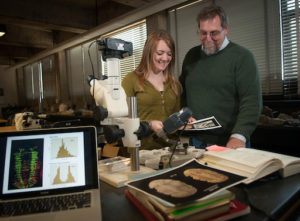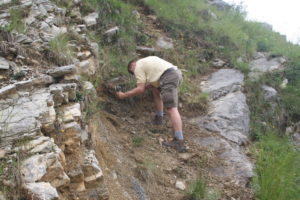Students with an interest in paleontology have several opportunities to conduct research at SUNY Cortland. Not only is the Cortland area amongst the best regions in the world to collect and study Devonian-aged fossils, but students have had the opportunity to conduct and assist in paleontological research in places such as Austria, Italy, Alaska, British Columbia, and Nevada. Undergraduate students use this experience to develop skills in independent critical thinking, acquire knowledge that transcends classroom study, and as a stepping-stone to further research in graduate school. The results of student paleontological research often involve presentations on campus or at professional meetings, or even published in peer-reviewed journals. Undergraduate student researchers at Cortland can sometimes get funding to conduct their research through aid from faculty research grants, travel grants, or from competitive summer fellowships.
Over the past several years, several undergraduate students have been actively involved in a wide array of paleontological research projects including:
Cooper Malanoski (B.S. 2019). Burial diagenesis and geothermobarometry from Lower Devonian Heldebergian strata, eastern and central New York.
Gavin Davidson (B.S. 2019). Latitudinal biodiversity gradients of late Paleozoic and early Mesozoic synapsids.
Brynn Crocker (antic. B.S. 2021). Feeding behavior of Zoophycus from the Early Devonian Oriskany Formation of eastern New York.
Taylor Buckley (B.S. 2019). Hypercalicifying megalodontoid bivalves and the end-Triassic mass extinction.
Shaolin Censullo (B.S. 2018). Taphonomy of Triarthrus trilobite assemblages from the Ordovician Utica Shale, central New York.
Tiffany Leone (B.S. 2018). Mineralogical and stereom microstructure of pink crinoids from the Becraft Formation, eastern New York.
Joseph Cataldo (B.S. 2016). Accelerated faunal turnover and evolutionary rates following mass extinction events.
Michelle TenEyck (MAT. 2014). Morphometrics of the Devonian bivalve Actinopteria.
Jeri Burke (B.S. 2013). Original color spots in phacopid trilobites from the Devonian of western New York.
Carolyn Furlong (B.S. 2012). Commensal sponge and worm boring traces on brachiopod hosts from the Middle Devonian of central New York.
Robert Hornung (B.S. 2010). Paleoecology of shelly accumulations from a well-preserved fossil locality of the Middle Devonian Ludlowville Formation of central New York.
 Jonathon Zabron. (B.S. 2009). Faunal change across the end-Triassic mass extinction in the Lombardian Alps of northern Italy.
Jonathon Zabron. (B.S. 2009). Faunal change across the end-Triassic mass extinction in the Lombardian Alps of northern Italy.
Kathrine Newman (2008). SEM analyses of skeletal microstructure of silicified bivalve fauna from the Upper Triassic of southeastern Alaska,
Adriel Shea (B.S. 2007). Two projects: (1) Faunal change across the end-Triassic mass extinction in the Northern Calcareous Alps of Austria, (2) Rhaetian (Late Triassic) Monotis (Bivalvia: Pectinoida) from the eastern Northern Calcareous Alps (Austria) and the end-Norian crisis in pelagic faunas.
Jason Smith (B.S. 2006). Shell bed genesis and taphonomy of a well-preserved fossil locality of the Middle Devonian Ludlowville Formation of central New York.
James Morgenthein (B.S. 2005). Bivalve diversity of the Triassic of Atigun Gorge, Arctic Alaska.
Emily Hopkin (B.S. 2005). Two projects: (1) A new Middle Triassic “flat clam” from the Middle Triassic of western Nevada; (2) bivalve diversity of the Upper Triassic of southeastern Alaska.
Jeffery Shanner (B.S. 2001). Bivalve diversity of the Upper Triassic of British Columbia, Canada.